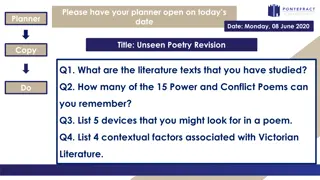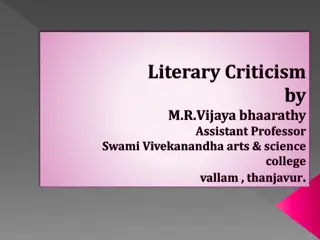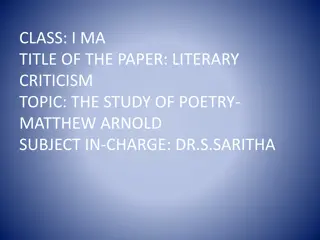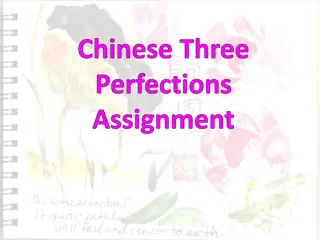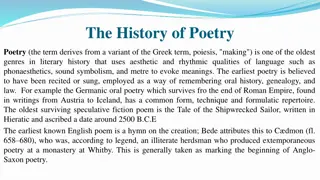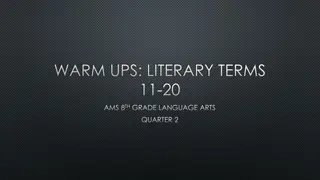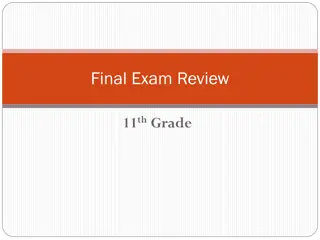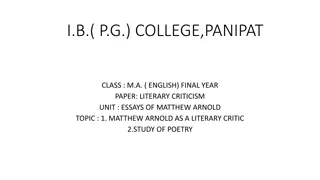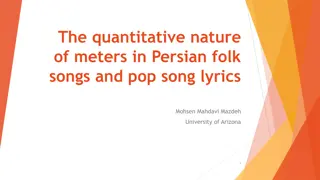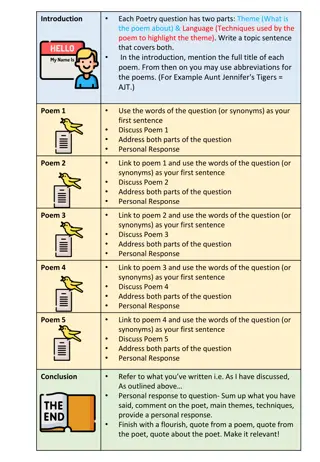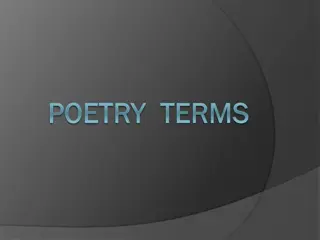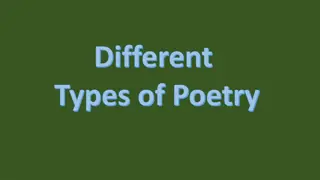Elements of Poetry - Understanding Literary Terms in Writing
Explore the nuances of poetry through key literary terms like mood, imagery, connotation, alliteration, assonance, consonance, figurative language, repetition, stanza, and more. Understand how each element contributes to the depth and richness of poetic expression.
Download Presentation

Please find below an Image/Link to download the presentation.
The content on the website is provided AS IS for your information and personal use only. It may not be sold, licensed, or shared on other websites without obtaining consent from the author.If you encounter any issues during the download, it is possible that the publisher has removed the file from their server.
You are allowed to download the files provided on this website for personal or commercial use, subject to the condition that they are used lawfully. All files are the property of their respective owners.
The content on the website is provided AS IS for your information and personal use only. It may not be sold, licensed, or shared on other websites without obtaining consent from the author.
E N D
Presentation Transcript
Mood the general atmosphere created by the author s words. It is the feeling the reader gets from reading those words. It may be the same, or it may change from situation to situation.
Imagery Appealing to the five senses
Connotation Emotions and feelings attached to a word There is no place like home vs. There is no place like my residence.
Alliteration a number of words, having the same first consonant sound, occur close together in a series. Peter Piper picked a pack of pickled peppers. How many pickled peppers did Peter Piper eat?
Assonance Assonance takes place when two or more words close to one another repeat the same vowel sound but start with different consonant sounds. Men sell the wedding bells. Go and mow the lawn.
Consonance Consonance refers to repetitive sounds produced by consonants within a sentence or phrase. This repetition often takes place in quick succession such as in pitter, patter. Mike likes his new bike. The black sack is in the back. He thrusts his fists against the posts and still insists he sees the ghosts.
Figurative Language Language used to not to be taken literally. You use figurative language to evoke certain feelings or provide a vivid mental picture. Examples: Personification (giving non-human things human like qualities) Similes (comparison of two or more things using like or as) Metaphors (comparison of two or more things without using like or as) Onomatopoeia (when a word sounds like its meaning or action) Hyperbole (exaggeration for dramatic effect)
Repetition A word or line is repeated throughout a poem to create a certain effect
Stanza A group of lines forming a paragraph in a poem
Rhythm A musical quality created by the alternation of accented and unaccented syllables
Acrostic Poems Acrostic Poetry: In Acrostic poems, the first letters of each line are aligned vertically to form a word. The word often is the subject of the poem. L oves to play on the computer A lways humorous U nique in every way R unning, jumping, tumbling at gym E xceptionally bright L earner
Cinquain Cinquain poems are five lines long with a certain number of syllables or words in each. Cinquain poems do not rhyme. There are many ways to write cinquain poems. Here is an example of one cinquain pattern. Line 1: Title - one word or two syllables Line 2: Description or example of the title - 2 words or four syllables Line 3: Action about the title - a 3 word phrase or six syllables Line 4: a 4 word phrase describing a feeling about the title or 8 syllables Line 5: Synonym for the title - one word - 2 syllables Line 1: Panther Line 2: Sleek, graceful Line 3: Running, hiding, emerging Line 4: Happy to be free Line 5: Cat
Couplet Poems The couplet is the easiest of the verse forms. It consists of two lines with an end rhyme. Grandmother sits in her old rocking chair. She rocks and she rocks all day there.
Concrete Poems Concrete poems form a picture of the topic or follows the contour of a shape that is suggested by the topic. For example:
Diamonte Diamonte: Diamonte poems are easy poems to write. You need to think of a subject and its opposite and then follow the format listed below: First line: one word (subject). Second line: two adjectives describing the subject Third line: three words ending in -ing telling about the subject Fourth line: four words, the first two describe the subject and the last two describe its opposite Fifth line: three words ending in -ing telling about the opposite Sixth line: two adjectives describing the opposite Seventh line: one word (opposite from the first line) Example:
Limericks Limericks: A limerick is a funny little poem containing five lines. The last words of the first, second, and fifth lines rhyme with each other (A) and the last words of the third and fourth lines rhyme with each other so the pattern is AABBA. It should also have a rhythm pattern, like da DUM da da DUM da da DUM for the first, second, and fifth lines (A) and da da DUM da da DUM for the third and fourth lines (B). Make sure your limerick has the pattern by reciting it with da for all unaccented or unstressed syllables and DUM for all the accented or stressed syllables. Here is an example of a limerick: 1. There once was a girl named Cheryl (A) da DUM da da DUM da da DUM 2. Who dreamed she was in great peril (A) da DUM da da DUM da da DUM 3. She awoke wtth a fright B) da da DUM da da DUM 4. When she discovered the sight (B) da da DUM da da DUM 5. The monster was just a small squirrel. (A) da DUM da da DUM da da DUM
Haiku Haiku: A form of centuries old Japanese poetry that consists of seventeen syllables and has nature as its subject or theme. Haiku is very short and has a 5-7-5 syllable structure with 5 syllables in the first line, 7 syllables in the second line, and 5 syllables in the third line. With just a couple of words, haiku poetry conveys emotion. It suggests that the reader look and listen to the world. This poetry was created by a famous writer named Issa. He had a very sad life. His mother died when he was two and his own four children all died before they were a year old. As a writer and poet, this sadness, loneliness and compassion helped him be more sensitive to everything around him. Issa took the time to listen and enjoy the beauty he found as he heard crickets chirp and as he gazed at the skies. Issa saw the beauty of the natural world around him; he valued every living thing, even insects, and wanted to share his love of nature through his haiku. Haiku requires you to observe! Here is an example of haiku: As I lay and gaze Blue skies and white clouds Billowing high above me
Tanka Tanka is another form of Japanese poetry that consists of 31 syllables (5-7-5-7-7). The themes for Tanka are love, nature, seasons, and friendships, Here is an example of Tanka: Wind Wind blowing my face Making my cheeks rosy red It's biting my nose And chilling through all my bones It is pushing me along





